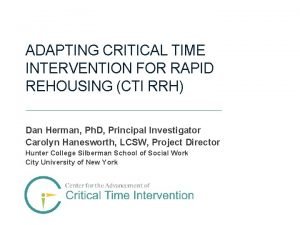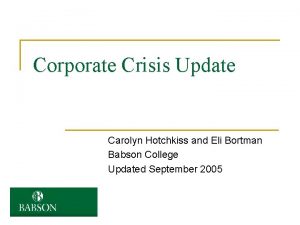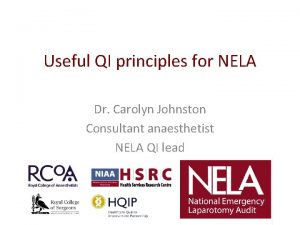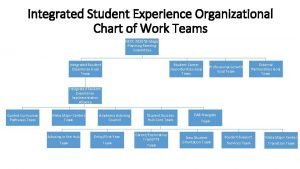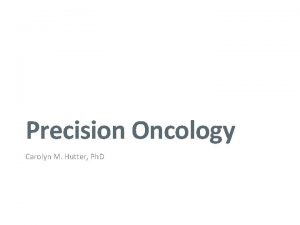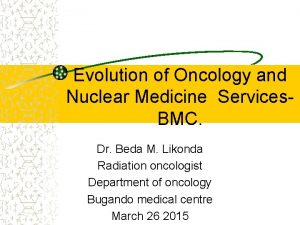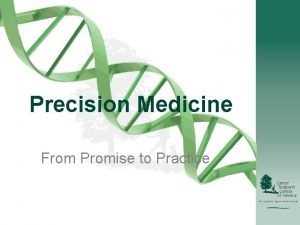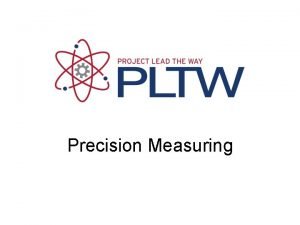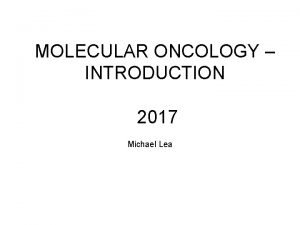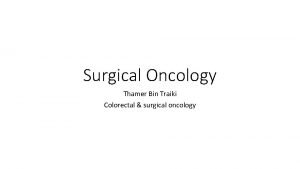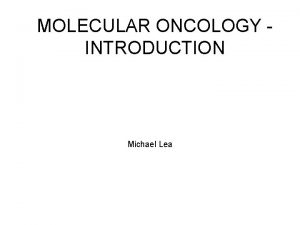Precision Oncology Carolyn M Hutter Ph D 1

























- Slides: 25

Precision Oncology Carolyn M. Hutter, Ph. D 1

2015 Precision Medicine Initiative: Two Components: Cancer & National Cohort “An emerging approach for disease prevention and treatment that takes into account people’s individual variations in genes, environment, and lifestyle”

Why Precision Medicine Clinical: • Many diseases lack effective preventive strategies, diagnostics, or treatments • Options fail to consider key differences among individuals: genes, lifestyle, environment Research and participants: • Need enough research to draw on for scientific and clinical evidence • Need to overcome siloed data and data resources 3

Building a Knowledge Base • Key Concept underlying most Precision Medicine Efforts • Collect multi-dimensional information on large numbers of participants • Share this knowledge • Analyze the information • Apply it in ways that impact individual and population health 4

Levels of Prevention Primary • Reduction of risk factors • Impact before disease develops Secondary • Early detection/Screening • Asymptomatic phase of disease Tertiary • Treatment to improve disease outcomes • Existing symptomatic disease 5

Precision Medicine is NOT just genomics! Precision medicine is an emerging approach for disease treatment and prevention that takes into account individual variability in lifestyle, environment, and genes. Breast Cancer Risk From Modifiable and Nonmodifiable Risk Factors Among White Women in the United States JAMA Oncol. 2016; 2(10): 1295 -1302. doi: 10. 1001/jamaoncol. 2016. 1025

Multi-Gene Panels • Increasingly commonly used in cancer risk setting • But how strong is the evidence that variation in the genes on the panel cause the disease in question? 7 7

Clin. Gen Clinical Validity Summary Matrix Assertion criteria Description 0 # Probands Total # of unrelated probands with variants that provide convincing N/A evidence for disease causality across all curated literature Functional evidence Points given based on the gene-level functional evidence supporting a role for this gene in disease 0 # of curated Independent publications # reporting human variants in the gene N/A Publications under consideration Time (yrs) 6 10 -12 13 -15 16 -18 7 1 -3 4 -6 7 -9 1 2 3 4 5 6+ 1 2 3 4 5+ ≥ 3 yr # of years since first publication reporting a disease association (if ≤ 2 this yr 1 -3 yr publications --> then 1 is max score for time) Is there valid contradictory evidence? Description of Contradictory Evidence: 1 Number of Points 2 3 4 5 19+ Total Y/N? Classification Score Limited: Moderate: Strong: Definitive: 2 -8 9 -12 13 -16 17 -20 Assertion: Explanatory video available at: http: //calculator. clinicalgenome. org/ashg-2015

“Building a genomic knowledge base to improve patient care. ” 9

Hereditary Cancer WG: Preliminary classifications suggest 50% of curated genes on clinical multigene panels for pancreatic cancer demonstrate only limited evidence Definitive Strong Moderate Limited Figure by Raj Ghosh * Pending expert review

Precision Cancer Genomics Applications of Genomics in Clinical Cancer Care • • Diagnostic subclassifications Novel prognostic biomarkers Genomic predictors of response to therapies Genomic mechanisms of resistance to therapies

12

• 21 gene test that predicts recurrence for HR+ women • Only 22% of those who meet guidelines were actually tested • Recurrence risk scores correlated with use of chemotherapy • Introduction of test associated with modest decrease in overall chemotherapy use

Paradigm for Cancer Precision Medicine Levi Garraway, Journal of Clinical Oncology, 2013

Assigning Meaning: What is an Actionable Tumor Genomic Alteration? An “actionable” tumor genomic alteration is a Clinically Relevant genomic finding in a patient’s tumor sample that has implications for clinical care. • Therapeutic implications – Sensitivity to Therapies – Resistance to Therapies • Prognostic implications • Diagnostic implications Slide by Nick Wagle Examples: BRAF V 600 E mutations may predict sensitivity to RAF inhibitors in melanoma KRAS codon 12 and 13 mutations may predict resistance to anti-EGFR antibody treatment in colorectal cancer Certain IDH 1 mutations may predict favorable prognosis in gliomas BCR-ABL translocations are diagnostic, prognostic, and predictive of response to treatment with imatinib

NCI and the Precision Medicine Initiative® • NCI is focusing its PMI activities on four broad areas: • Expanding Precision Medicine Clinical Trials • Overcoming Drug Resistance • Developing New Laboratory Models for Research • Developing a National Cancer Knowledge System

Genomically Based Clinical Trials Umbrella Trials Basket Trials • Same Tumor • Different mutations • Test impact of different drugs on different mutations in a single cancer type • Different tumors • Similar mutations • Test effect of a drug on single mutation in a variety of cancer types

NCI Precision Medicine Trials: Lung-MAP

NCI Precision Medicine Trials: NCI Match

Basket Trial Example 20

Pediatric MATCH 21

Ethical, Legal, and Social Implicaitons (ELSI) Study 22

Sharing Clinical Interpretation in Cancer Genomics

Tension Between Precision Medicine and Public Health JAMA, June 2015 Too much emphasis on healthcare! “We worry that an unstinting focus on precision medicine… is a mistake — and a distraction from the goal of producing a healthier population. ” Bayer and Galea, NEJM, 2015

Summary • Precision Medicine takes into account individual differences in people’s genes, environments, and lifestyles. • Precision Medicine may impact cancer at primary, secondary and tertiary prevention • Cancer genomics is on the leading edge of genomic medicine (as are pharmacogenomics and rare diseases applications) • Current precision medicine efforts include a focus on building knowledge basis and knowledge systems, including genomics
 Reinhard hutter
Reinhard hutter Precision and non precision measuring instruments
Precision and non precision measuring instruments Precision and semi precision attachments
Precision and semi precision attachments Negatif sayıların binary gösterimi
Negatif sayıların binary gösterimi Carolyn talbot
Carolyn talbot Carolyn cherry
Carolyn cherry Carolyn hanesworth
Carolyn hanesworth Carolyn brownawell
Carolyn brownawell Synchronicity market timing
Synchronicity market timing Carolyn hotchkiss
Carolyn hotchkiss Carolyn johnston md
Carolyn johnston md Carolyn knoepfler
Carolyn knoepfler Carolyn maull
Carolyn maull Levi carolyn ph
Levi carolyn ph How to tell wild animals book
How to tell wild animals book Upton lake christian school
Upton lake christian school Carolyn shread
Carolyn shread Carolyn saxby facts
Carolyn saxby facts Carolyn has 20 biscuits in a tin tree diagram
Carolyn has 20 biscuits in a tin tree diagram Carolyn marano nj
Carolyn marano nj Carolyn sourek
Carolyn sourek Carolyn washburn
Carolyn washburn Carolyn graham jazz chants
Carolyn graham jazz chants Carolyn mendiola
Carolyn mendiola Carolyn ells
Carolyn ells Bmc oncology department
Bmc oncology department






